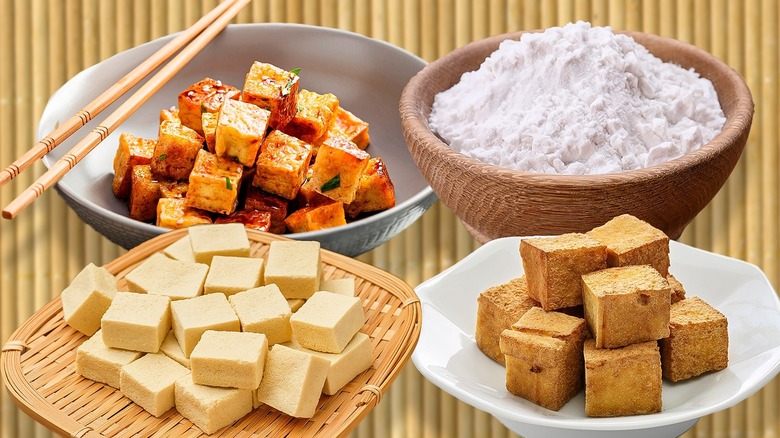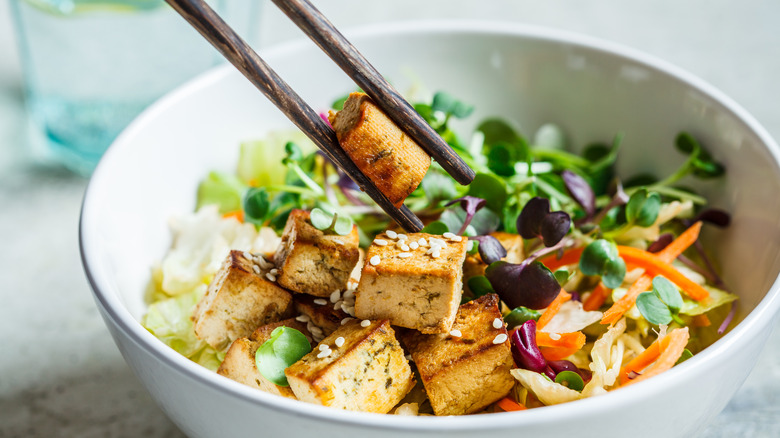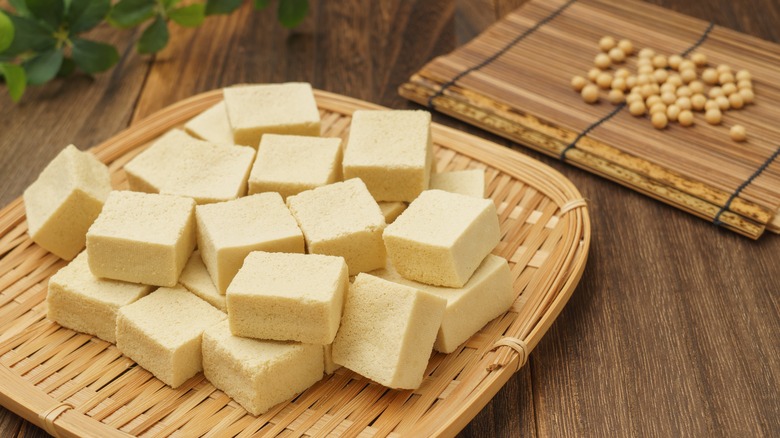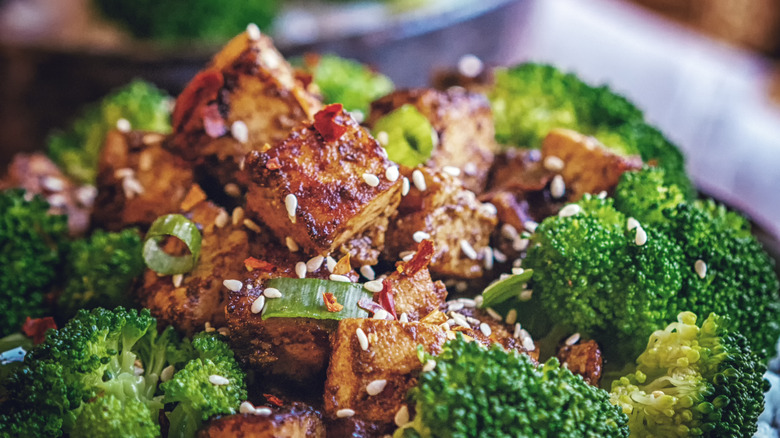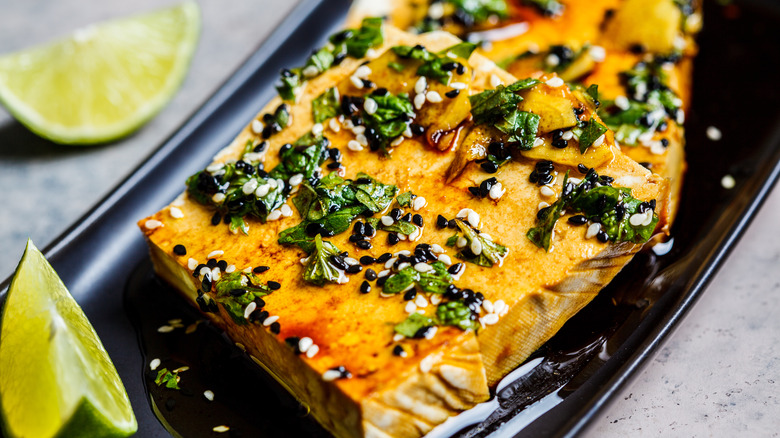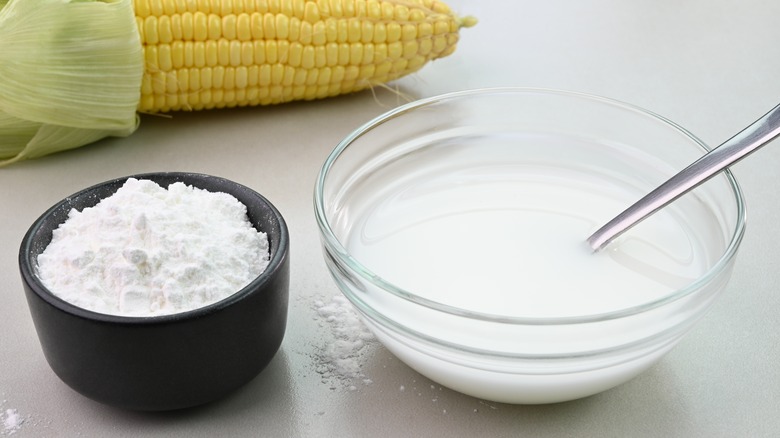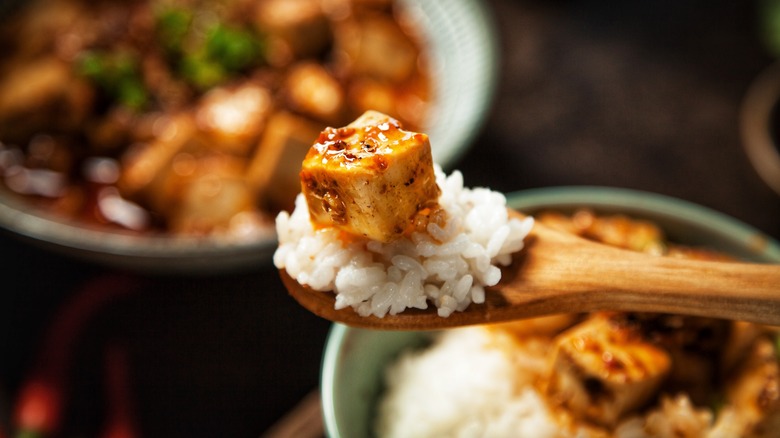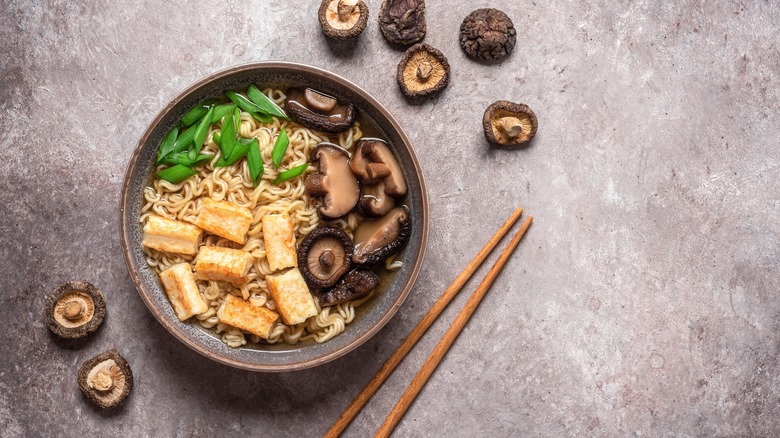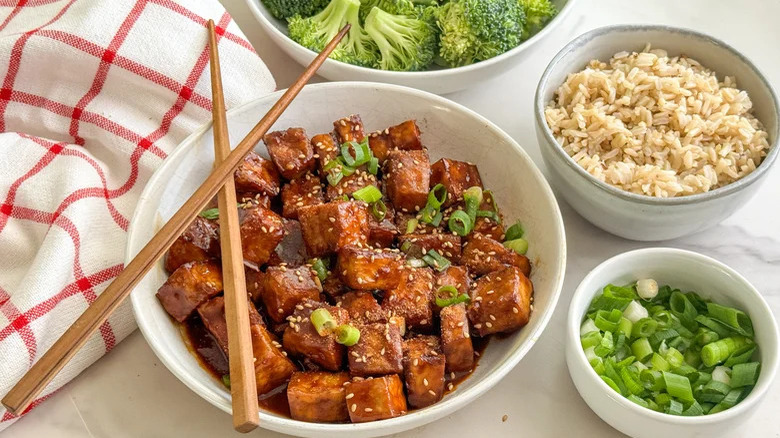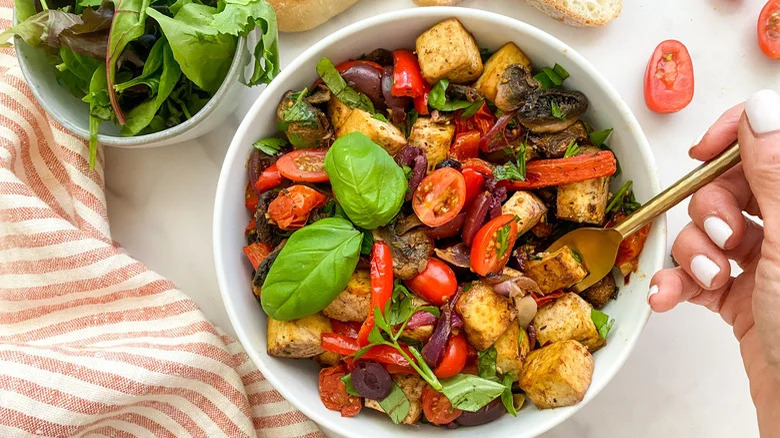13 Tips You Need When Roasting Tofu, According To A Professional Chef
Veggies may have a bad rap, but compared to tofu, they taste like candy. Like many other folks, I had a strong aversion to eating tofu when it was first served on my childhood dinner table. I would even sit at the table until the sun came up the next day to protest eating the putrid white sponge.
Years later, my mother admitted that she had no idea how to cook tofu and made it clear that my siblings and I were simply tortured subjects of her dietary pursuits. She's sharpened her tofu skills considerably since those days and, thankfully, passed them along to me. In my time experimenting with different cooking methods for tofu, including roasting, I've learned that you can't approach it like other proteins. While roasted tofu is handy and versatile in a pinch, you have to learn how to cook it correctly for it to truly shine.
Roasted tofu can be a protein boost for your morning scramble, a savory yet light lunchtime snack, or a filling complement to a nutritious dinner. Thanks to my mother's endearing effort, tofu has become a significant part of my life, and it can be a new favorite protein of yours, too. Here are essential tips I have learned over the years that will change the way you roast tofu.
1. Use the right variety of tofu
Cooking with tofu is all about choosing the right variety. Understandably, the numerous types of tofu can confuse first-timers. Some recipes call for a silken style, which has a soft, milky texture, while others require a style with more firmness. You should always use extra-firm or super-firm tofu for roasting. These blocks have a tougher consistency that does not break apart as easily and can withstand the heat of your oven. Save your silken tofu for an egg replacement, in a smoothie, or for other uses where the custardy texture is more desirable.
Fortunately, extra firmness will not cost you extra bucks. Most tofu styles, which can be found in the store's health foods or produce section, are priced the same and come in a plastic container. Specialty tofu products, like smoked, fermented, or seasoned varieties, may cost a little more — but you can save some money and do this yourself. Both unflavored and flavored tofu can be roasted as long as the consistency is at least extra-firm.
2. Remove excess liquid before roasting
Most store-bought tofu comes in a container of water that helps preserve its freshness and consistency. For many recipes, all you have to do is pour the water out, and you are good to go. Others require that you press your tofu to remove the excess liquid. Water and roasting do not work well together, so this is one application where you'll want to drain the water from the block. Excess water can make your spongy tofu crumble and prevent it from developing a crispy outer layer.
You'll want to ensure that your tofu is pressed to perfection to get this desirable crust. While some recipes recommend pressing tofu for at least a half-hour, you can also turn to your microwave as a quick way to drain moisture from tofu. All you need to do is wrap the block in a paper or clean kitchen towel and microwave it until the moisture evaporates.
3. Cut tofu into your preferred shape
Learning how to properly cook tofu for the first time can be challenging. Beyond choosing the right variety, deciding when and how to season your tofu is key. For one, seasoning tofu while it's cooking is less effective than marinating it beforehand. You should cut your tofu into cubes before marinating so that the seasoning infuses into it rather than just flavoring the exterior of the block.
Tofu's sponge-like consistency can be its superpower. Because it soaks up seasoning so well, there are endless ways to infuse it with mouthwatering flavor. You can make a jerk-marinated tofu with all the spicy essentials, like nutmeg, allspice, ginger, and thyme. If you're looking for some Korean flare to pair with your rice bowl, bulgogi-style tofu is sure to satisfy. Although this recipe is designed for shredding, you can adapt the gochujang-based seasoning to your roasted tofu, too.
4. Try oil-free roasted tofu
One of the best things about tofu is that it can be roasted with or without oil. While oil can help deliver more crispiness, all you need is parchment paper and a baking sheet to give tofu a golden, flaky skin. Cornstarch or another thickening agent is also helpful if you're opting for an oil-free preparation.
Oil-free roasted tofu can be a healthier alternative, as high smoke point options like soybean and canola can create a greasy residue and make your dish unnecessarily heavy. Sauces and marinades can replace the flavor and moisture of the oil. So, rest assured — your dish will be just as delicious if you skip the oil.
Like other roasted tofu preparations, you'll want to start by draining and cubing your tofu. You can even use the container to drain your block. After pouring out the water, I like to flip the container over and squeeze the tofu with the palm of my hand — it's just water, after all. After the tofu cubes are seasoned, I toss them into the oven. I always make sure that I flip the tofu halfway through the cooking process to ensure that it gets cooked properly on all sides.
5. Choose an oil with a high smoke point
Selecting the proper cooking oil is important for roasting tofu and anything else you decide to roast. Every oil has a threshold of heat it can withstand, which is called a smoke point or a flash point. When oil reaches its smoke point, it starts to burn. The smoke, in turn, releases a compound called acrolein that infuses food with a bitter, acrid flavor. If your first instinct is to add more oil — don't. It will only expose your food to additional smoke. Oil will begin burning once it reaches its smoke point, no matter the quantity used.
It all comes down to choosing an oil that can handle the temperature you're cooking it at. Not only will you have tasty tofu, but you also won't have to throw it out when it gets too toasty. When roasting tofu, I recommend using sunflower or avocado oil. The former has a respectable smoke point of 450 F, while avocado has an even higher smoke point of 520 F. Vegetable, peanut, canola, and grapeseed oils also work.
That said, you can still use oils that have smoke points below 400 F, but you should be very careful when cooking with them. For example, extra virgin olive oil has a smoke point range of 350 to 410 F. Along with crispy skin, it can give tofu a delicious grassy flavor.
6. Marinate tofu overnight
Anyone who has braved the blandness of tofu knows how game-changing a good marinade can be. Marinades introduce flavor by tenderizing foods, thereby allowing fluid and seasonings to permeate through them. They typically include an acidic ingredient like vinegar, wine, fruit juice, pineapple, papaya, guava, or ginger.
The best way to infuse flavor into your tofu is to marinate it overnight because max time means max flavor. Mustering up enough patience to wait is the biggest challenge you'll face. Of course, you don't have to wait that long, but I recommend marinating your tofu for at least two hours.
You can try a store-bought marinade or make one from scratch. Try being adventurous when choosing one for your roasted tofu. Classic Asian flavors like sesame, ginger, and gochujang will certainly satisfy — but those only scratch the surface of what's possible. Tofu goes great with almost any flavor, from hickory barbecue to enchilada sauce and more.
7. Toss the tofu with cornstarch or arrowroot powder
After removing excess liquid from your tofu and marinating it overnight, it's time to prepare it for the oven. You can bread tofu by coating it in flour, but I like to use cornstarch because it does a great job of soaking up the remaining moisture and helping the skin brown. You can also substitute your cornstarch with another thickener, like potato starch, rice flour, or arrowroot powder. These starches are also gluten-free alternatives to all-purpose flour, which are suitable for folks with gluten intolerances or allergies.
It's important to note that not all starches perform the same way. Rice flour, for example, won't thicken as much as cornstarch, so you will need twice the amount. Arrowroot powder has the same thickening strength as cornstarch, but it doesn't keep together as well, so it works better for food you plan to eat right away. Regardless of what starch you have on hand, be sure not to overuse it. You should only apply a thin layer to coat your tofu. Otherwise, you'll risk it clumping up.
Use your hands to gently rub the starch into the tofu until it's fully covered, or put a lid over the mixing bowl and shake it around. Before placing your starched cubes on a baking pan, shake each one softly to remove the loose powder.
8. Don't be afraid to use salt
Tofu is stubborn when it comes to seasoning; simply sprinkling some on top doesn't always produce the most flavorful results. While marinades do an excellent job of adding flavor to tofu, seasoning can elevate this protein even more. For example, before cubing the tofu, I sometimes like to add salt to the block. Tofu often tastes better at restaurants because the chefs pre-season the tofu before cooking it. This is because salt adds flavor and extracts moisture, which helps the tofu roast better. Brushing away any remaining crystals before cooking is important, as biting into the salt can be unpleasant.
Another satisfying seasoning method is to incorporate salt and seasoning blends into your starch batter, just like you would do for fried fish or chicken. Any of your favorite store-bought seasoning blends, from five-spice powder to za'atar, can work. Custom blends are equally as effective. Along with taste, seasoning adds texture. Ingredients like red pepper flakes, poppy seeds, and sesame seeds make your roasted tofu crunchy.
9. Briefly cook the tofu on high heat before baking it
Once you've mastered the seasonings, it's time to get to cooking. If your past experiences with tofu resulted in a gummy consistency, there could be several reasons why. The lingering moisture could be a major culprit if you don't drain enough liquid from the block beforehand. You should also be mindful how much of starch you use because the coating will clump rather than crisp up.
Since tofu is porous, any remaining water will release as it cooks. While there are several ways to pull out any moisture, one of the best tricks for ultra crispy tofu is to briefly cook it on high heat before you bake it. Tofu can easily get crunchy at high temperatures — as long as it has enough air flow on all sides. If you cook tofu on high heat before roasting it in the oven, you will increase the chances of a satisfyingly crispy coating. There is a stovetop approach to this, too. When using a pan, cook your tofu without a lid because steam will trap the moisture rather than drying it out.
10. Add your roasted tofu to ramen
When it comes to tofu dishes, ramen holds the crown. It's one of the world's most beloved noodle-based broths because it comes in endless styles and flavors. In many popular ramen recipes today, tofu, particularly firm or extra-firm varieties, has become almost as ubiquitous as noodles. Tofu has the perfect chameleon-like canvas to elevate whatever is in your bowl. Like your favorite meats, roasted tofu adds a burst of protein-rich umami to ramen. The skin has a firm layer that resists sogginess and adds texture to an otherwise slurpy experience.
This fresh kimchi ramen bowl offers a full-bodied explosion of flavor with the addition of roasted tofu. If you're looking for the ultimate indulgence, you can put a tofu spin on this classic tonkotsu ramen recipe by pairing your roasted tofu with the pork bone broth. Adding this protein to your ramen doesn't mean cooking all day, either. You can spruce up instant ramen with delicious roasted tofu, mushrooms, and bok choy. You'll be swimming in oodles and noodles of tofu tastiness.
11. Get your fiery fix with sriracha tofu
Let's face it: Life is more exciting when you spice things up. The same fiery flavors that you enjoy on your favorite meats taste just as delicious atop tofu. One of my favorite combinations of spicy and savory is sriracha. It's a simple yet seriously delicious Thai condiment made with chili peppers, vinegar, garlic, salt, and sugar. Sriracha delivers a tongue-tingling 2,200 Scoville heat units (SHU). For reference, Cholula is milder and packs between 1,000 to 2,000 SHU, while Tabasco blazes the mouth with 2,500 to 5,000 SHU.
Sriracha tofu can be enjoyed by folks who aren't keen on super spicy things, too. If you can't stand the heat in the kitchen, try adding less hot sauce to dial down its spice level. Just toss the cubes with the sriracha sauce and other seasonings until it's flavored to fit your palate. Beyond the usual applications, try putting a sriracha-flavored tofu twist on this plant-based shawarma pita. You can also make roasted sriracha tofu spring rolls as a snack or for your next get-together.
12. Swap your negi-yaki with marinated roasted tofu
Negi-yaki isn't just fun to say, it's also pretty delicious to eat, too. It's a rich, savory Japanese pancake popular in Osaka and is made with flour, eggs, dashi, yam, and green onions. Negi-yaki is a type of okonomiyaki, an umbrella term for savory Asian pancake dishes. This distinct regional preparation uses green onions rather than cabbage. That said, some iterations include cabbage and Japanese leeks (referred to as "negi") as well. Traditionally, negi-yaki is served with a delicious drizzle of soy sauce or a sweet barbecue-style sauce and Japanese Kewpie mayo.
If that got your stomach's attention, try making the recipe with roasted tofu instead of an omelet. It replicates the flavor profile of traditional negi-yaki without the pan-fried heaviness. You can easily add the same punchy allium flavor with shallots and garlic and a hint of spice from Japanese chile powder. This recipe is just one way roasted tofu can act as the star of your whole meal; you just have to get creative with your seasonings.
13. Toss it on a sheet pan with your favorite veggies
There are more ways to pair roasted tofu with complementary ingredients than you might think. Mediterranean flavors and ingredients can offer a light alternative to the rich, heavy sauces commonly found in Asian-inspired preparations of the protein. For example, you can make a Mediterranean sheet pan tofu recipe for a quick, flavorful, one-pan dinner. Notably, the salty kalamata olives are a mouthwatering tofu complement that you didn't think you needed. It'll open up your culinary imagination to what's possible with roasted tofu and help you find ways to pair it with other foods.
This zesty and herbaceous recipe can be enjoyed as a hearty and healthy midday meal or as a nutritious dinner. You can serve it as a protein-rich side or forgo forks in favor of a wrap or pita. It's also a great recipe to impress your friends and family.
